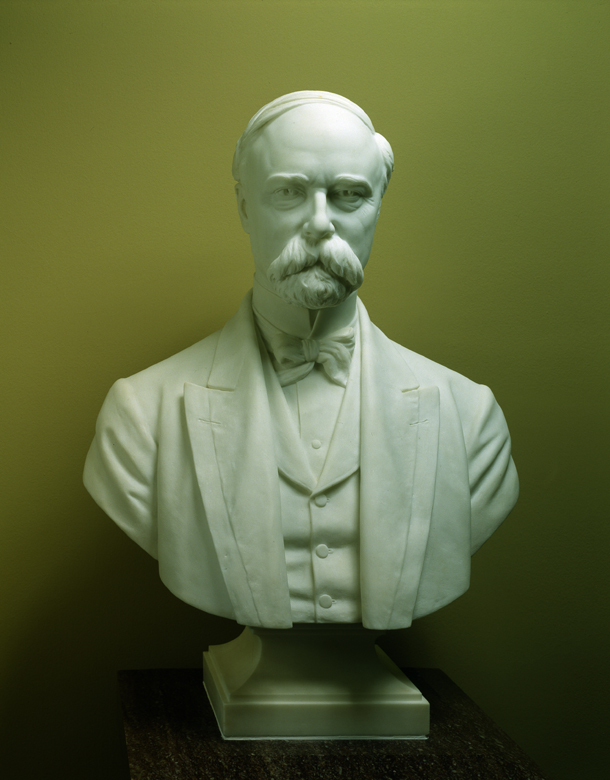
| Title | Charles W. Fairbanks |
| Artist/Maker | Franklin Bachelder Simmons ( 1839 - 1913 ) |
| Date | 1905 |
| Medium | Marble |
| Dimensions | h. 36 x w. 25 x d. 16.88 in. (h. 91.4 x w. 63.5 x d. 42.9 cm) |
| Credit Line | U.S. Senate Collection |
| Accession Number | 22.00026.000 |
Neoclassical sculptor Franklin Simmons specialized in depicting Americans and American history, though he spent most of his career in Rome. Born and raised in Maine, Simmons briefly studied under John Adams Jackson in Boston. For two years in the mid-1860s, the sculptor lived in Washington, D.C., and modeled Civil War officers Ulysses S. Grant, William T. Sherman, and David G. Farragut. Soon afterward, Simmons moved to Rome, where, like others of his generation, he was attracted by the availability of materials and assistants and by the creative environment.
Charles Fairbanks was vice president-elect in 1905 when he sat for the bust intermittently during visits to Washington. The sculptor, who had previously created busts of Vice Presidents Hannibal Hamlin and Adlai E. Stevenson for the U.S. Capitol, apparently believed that his proposal for a likeness of Fairbanks had been officially accepted. But when the completed bust of Fairbanks later arrived in Washington from Rome, Architect of the Capitol Elliott Woods informed the sculptor that the Joint Committee on the Library had not officially sanctioned the commission. The bust of Fairbanks therefore remained in storage at the Washington Custom House for two years. Finally the vice president notified the committee that selection of Simmons as the sculptor was “entirely satisfactory” to him. The marble bust of Fairbanks was approved and placed in the Senate Chamber in 1909.
In addition to the three busts and four statues by Simmons in the U.S. Capitol, the artist is represented in Washington, D.C., by the Peace Monument at the base of Capitol Hill and the equestrian statue of General John A. Logan at Logan Circle. The artist left a sizable collection of his work to the Portland Museum of Art in his native state of Maine.
A prosperous Indianapolis attorney who was active in the Republican Party, Charles Warren Fairbanks served as both a U.S. senator from Indiana and 26th vice president of the United States. Born in Union County, Ohio, Fairbanks was a keynote speaker at the 1896 Republican National Convention that nominated William McKinley for president. In that same year, Fairbanks was elected to the U.S. Senate, where he served from 1897 to 1905, chairing the Committee on Immigration and the Committee on Public Buildings and Grounds.
A leading conservative, Fairbanks was nominated for the vice presidency on the 1904 ticket with Theodore Roosevelt. Upon election, Fairbanks resigned from the Senate. Although he was a favorite son candidate for the Republican nomination for president in 1908, Roosevelt secured the nomination for his secretary of war, William Howard Taft. In 1916, when Fairbanks was again the favorite son from his home state, he reluctantly accepted the vice presidential nomination on the Republican ticket with Charles Evans Hughes. After their defeat in the election, Fairbanks returned to private life. He died in 1918.